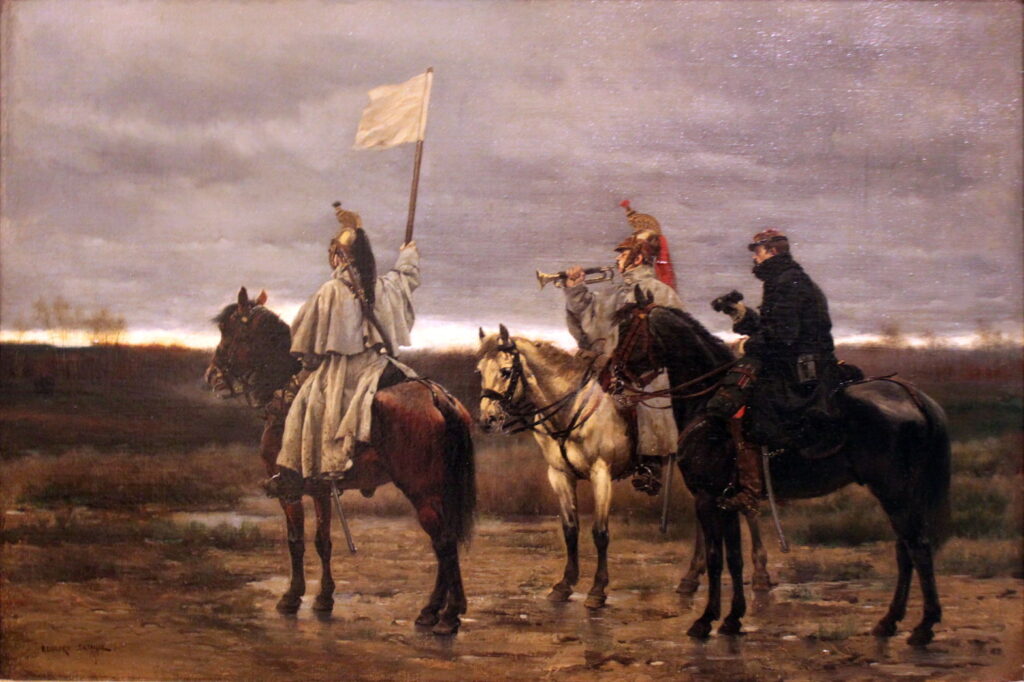Paintings of the Franco-Prussian War: 2 The Siege of Paris

Following a series of disastrous defeats of the French Army, on 19 September 1870, Prussian forces had taken control of the country around Paris, and put the capital under siege. With the surrender of the French Emperor Napoleon III, a provisional republican government had been established, and ushered in the Third Republic as successor to the Second Empire, in the most difficult of circumstances.
The new French government wasn’t yet ready to admit defeat. They called for guerilla warfare against the occupying Prussian forces to deprive them of supplies, and the formation of large armies from the unoccupied provinces to the west and south. Prussian opinion favoured the bombardment of Paris to try to bring the war to a more rapid conclusion, but thankfully Prussian High Command wouldn’t accept that on moral grounds.
As the Prussians sent small armies out to the provinces to disrupt French attempts at re-organisation, conditions in Paris steadily deteriorated.
Anton von Werner (1843–1915), In the Troops’ Quarters Outside Paris (1894), oil on canvas, 120 x 158 cm, Alte Nationalgalerie, Berlin, Germany. Wikimedia Commons.
Anton von Werner shows the contrasting life In the Troops’ Quarters Outside Paris (1894), here in the luxurious Château de Brunoy, which had been abandoned to or requisitioned by those occupying forces. Prussian soldiers were blamed for the almost complete destruction of Pissarro’s work prior to the war, when they occupied his house in 1870.
Édouard Detaille (1848–1912), Champigny, December 1870 (1879), oil on canvas, 121.9 x 218.4 cm, location not known. Wikimedia Commons.
Édouard Detaille’s painting of action at Champigny, December 1870 (1879) took place only 12.5 km (under eight miles) from the centre of Paris.
Alphonse-Marie-Adolphe de Neuville (1836–1885), Bivouac after the Battle of Bourget, 21 December 1870 (1873), media and dimensions not known, Musée d’Orsay, Paris. Wikimedia Commons.
There were French counter-attacks. On 29 October 1870, General Carey de Bellemare attacked the Prussian Guard at Le Bourget, despite having no orders to do so, and forced them to cede the town to his troops. Despite these positions being of little value to either side, the Prussians re-took them in the Battle of Le Bourget on 30 October. Although incorrectly dated, de Neuville shows French soldiers sheltering in a Bivouac after the Battle of Bourget, 21 December 1870 (1873). This was a major blow to the beleaguered citizens still in Paris.
As the winter grew colder, Parisians were starting to starve. A city which had long been proud of its restaurants and food was reduced to scavenging meals based on horse, dog, cat, and even the city’s rats.
Jean-Louis-Ernest Meissonier (1815–1891), The Siege of Paris (1870), oil on canvas, 53.5 x 70.5 cm, Musée d’Orsay, Paris. Wikimedia Commons.
Jean-Louis-Ernest Meissonier’s romanticised view of The Siege of Paris from 1870 combines almost every symbol relevant to the city’s distress, dressing Marianne in a lionskin against a battle-worn flag. Meissonier had originally been attached to the staff of Napoleon III, and accompanied him in early phases of the war in Italy. During the siege of Paris, though, he was a Colonel commanding an improvised infantry unit, and knew well the realities of combat.
Gustave Doré (1832–1883), Sister of Charity Saving a Child. An Episode of the Siege of Paris (1870-71), oil on canvas, 97 x 130 cm, Musée Malraux (MuMa), Musée des Beaux-Arts, Le Havre, France. Wikimedia Commons.
Another artist who was trapped inside Paris was the great illustrator and painter Gustave Doré, who made several works showing scenes such as this Sister of Charity Saving a Child. An Episode of the Siege of Paris (1870-71).
Louis-Ernest Barrias (1841-1905), The Defence of Paris (1883), sculpture cast in bronze, dimensions not known, La Défense, Paris. Image by Velvet, via Wikimedia Commons.
The greatest memorial to those who lost their lives in the siege, and those who survived it, is Louis-Ernest Barrias’ bronze The Defence of Paris of 1883. This has so dominated the part of the city where it’s situated that the area is known as La Défense.
Military action continued into 1871, although it was already clear that France was utterly defeated. Secret discussions about an armistice started on 23 January, but the French government feared that their capitulation could precipitate rebellion, even revolution.
Édouard Detaille (1848–1912), The Armistice of 28th January 1871 (1873), media and dimensions not known, Deutsches Historisches Museum, Berlin, Germany. Wikimedia Commons.
Édouard Detaille’s depiction of The Armistice of 28th January 1871 (1873) shows the moment the symbolic white flag was raised over a bleak plain.
Anton von Werner (1843–1915), Crowning of Wilhelm I as Emperor of Germany, in Versailles (second version) (1882), media and dimensions not known, destroyed in World War 2. Wikimedia Commons.
To the nearly 400,000 French dead from the war, the Prussians were determined to add profound insult: as shown in Anton von Werner’s painting of the Crowning of Wilhelm I as Emperor of Germany, in Versailles (1882). Prussia had celebrated victory in this ceremony held at the most famous of French royal palaces, on 18 January 1871.
Emil Hünten (1827–1902), Welcome of Empress Eugénie by Prussian Soldiers (date not known), oil on canvas, 64.5 x 85 cm, location not known. Wikimedia Commons.
Neither were participants afraid to spread ‘false news’: Emil Hünten’s undated Welcome of Empress Eugénie by Prussian Soldiers shows an event that never occurred. When the Empress was told of her husband’s surrender to the Prussians at the Battle of Sedan, she’s reported to have said:
“No! An Emperor does not capitulate! He is dead!… They are trying to hide it from me. Why didn’t he kill himself! Doesn’t he know he has dishonored himself?!”
With hostile crowds forming outside her Tuileries Palace, she slipped out to find sanctuary in the company of her American dentist, then fled to England by yacht on 7 September 1870. She was later joined by the former emperor, and the couple lived at Chislehurst in Kent. She never fraternised with Prussian soldiers.
Gustave Doré had a deeply personal involvement, as he had been born in Strasbourg, a French city the Prussians had taken early in the war. He volunteered to serve in the National Guard, and produced several moving paintings of the suffering of Paris.
Gustave Doré (1832–1883), The Enigma (souvenirs de 1870) (1871), oil on canvas, 128 x 194 cm, Musée d’Orsay, Paris. Wikimedia Commons.
His The Enigma (souvenirs de 1870) and two other works were painted using grisaille, greys normally used to model tones in traditional layered technique. This shows the shattered and still-burning remains of the city in the background, bodies of some of the Prussian artillery in the foreground, and two mythical beasts silhouetted in an embrace. The winged creature is female, and probably represents France, who clasps the head of a sphinx, who personifies the forces that determine victory or defeat. The enigmatic question would then relate to the Franco-Prussian War, and the reasons for France’s defeat.
Over the next seventy-five years, France and Germany were to fight one another twice more, before the Treaty of London of 5 May 1949 created the Council of Europe, which West Germany joined in 1951, and became ancestor of the European Union.

